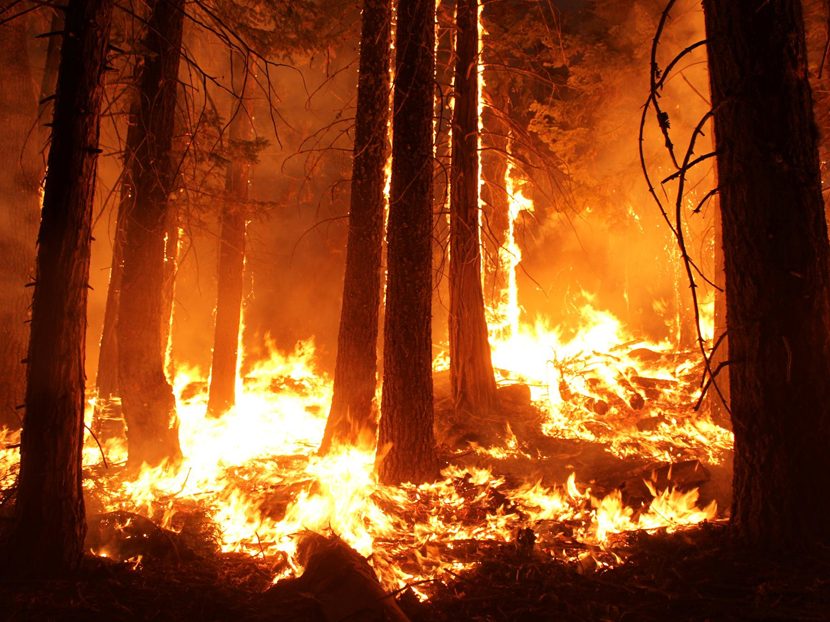Thoughts on Wildfires
Managing our forests properly and understanding the dangers of fires can help us all be more prepared.

Our prayers go out to the families and friends of the victims, as well as those left homeless by the recent California wildfires. Our gratitude goes out to thousands of first responders who go into harm’s way to effect rescues and fight these fires. At the writing of the column, the death toll in the Camp Fire is 84 people with 475 people missing. It has burned more than 250 square miles and destroyed more than 14,000 homes.
Some Historical Perspective
The Camp Fire is the deadliest fire in California history but it is far from the deadliest fire in U.S. history. One hundred and forty-seven years ago, the largest life-loss fire in the United States (not including the World Trade Center towers on Sept. 11, 2001) also was a wildfire — the 1871 Peshtigo Fire in northeastern Wisconsin.
This fire is relatively unknown because it began on Oct. 8, 1871, the same day Mrs. O’Leary’s cow allegedly started the Great Chicago Fire. The Chicago fire killed an estimated 300 persons, had property damage of approximately $200 million and destroyed 3.3 square miles of the city.
The Peshtigo Fire resulted in an estimated 1,200 to 2,500 fatalities; victims simply had no plan to run to or no way to hide. The fire burned 2,400 square miles and destroyed 12 towns in the area. One hundred years later, the Port Huron, Mich., wildfire covered 1,875 square miles and killed 50 people.
The 1871 fires had several contributing factors in common: prolonged drought conditions in the upper Midwestern states, high temperatures and strong winds.
The Chicago blaze had ample available fuel with large amounts of combustible construction and inadequate building separations. The Peshtigo wildfire also had an ample fuel supply — not only from the drought-stricken live forest but the poor land management practices of lumber operators. Clear-cutting left the soil vulnerable to significant erosion; eroded soil is less able to retain moisture. Also, slash — debris from log stripping — significantly added to the amount of dry fuel in the areas.
The Great Chicago Fire prompted changes in building codes, which helped make our cities safer. It appears far too few learned the lessons of Peshtigo. Huge wildfires have been occurring in our forests for eons, during which time forests have been adapting to fires.
Fire Ecologists Bring Important Perspective
There is a branch of environmental science called Fire Ecology. From the Pacific Biodiversity Institute,
“Fire ecology is a branch of ecology that focuses on the origins of wildland fire and its relationship to the environment that surrounds it, both living and non-living. … Fire ecologists recognize that fire is a natural process and that it often operates as an integral part of the ecosystem in which it occurs.”
The main factors examined in fire ecology are fire dependence and adaptation of plants and animals, fire history, fire regime and fire effects on ecosystems.
Through evolution, a wide range of pyrophitic plants — plants that have adapted to tolerate wildfire — have developed to help sustain and renew forests. Such adaptations include thick barks capable of retaining large amounts of moisture, plants with tall crowns, “self-pruning” trees which quickly shed dead branches, trees and shrub poised for rapid growth or blooming after fires, and pyrophiles.
Pyrophiles are plants that require fire for reproduction, such as lodgepole pines (very common to Yellowstone) and eucalyptus trees. Both have thick seeds sealed with resin that must be exposed to the heat of a fire to open and begin the germination process. Eucalyptus trees actually encourage the spread of fires by producing flammable oils. This helps reduce competition to the eucalyptus in the post-fire aftermath.
Fire also helps limit the invasion of forests by nonnative species, which tend to be less fire-tolerant and can increase fuel loads in forests. Invasion of forests by this less fire-tolerant vegetation is one of the unintended consequences of our firefighters being so very good at putting out wildfires.
Another unintended consequence is the important contribution fire makes to forest ecology has been diminished.
Given that tens of millions of people in the United States live in the urban-wildland interface, it is not reasonable to let all wildfires burn. However, where possible, agencies should continue to use natural and man-made wildfires as a forest management tool.
The severity of wildfires can be reduced through forest management. Many government jurisdictions are having success in reducing the fuel loads in fire-prone areas through forest thinning and prescribed burning. These efforts reduce “ladder fuels,” making severe crown fires — fire which spreads through the tops of trees — less likely.
Environmentalists must realize that large lumber interests are not all evil, that they have a vested interest in the success and sustainability of our forests and are, in many cases, good stewards of the environment. Always lobbying against responsible logging on public lands has helped to contribute to the severity of wildfires we’re experiencing today.
However, logging interests must be supervised to ensure best practices are used with thinning forests.
Understanding the Danger
As one can guess, the solution to the wildfire problem is tremendously complicated by those millions of people living in the urban-wildland interface. These people need to clearly understand the dangers they face. Residents need to understand that when the evacuation order is given, they must leave immediately. Those who refuse to evacuate or delay evacuation increase the risk to firefighters as they attempt to effect rescues and gain access to fireground through traffic-clogged roads.
In some cases, wildfires develop so rapidly that there is inadequate time to warn residents. We must continue efforts to identify areas for severe fire hazard potential and implement fuel-reduction measures. We must implement and vigorously enforce measures to harden and protect homes from wildfires, as well as create defensible space around homes. Many resources on the Internet have information homeowners will find useful.
• Dealing with the elderly. In looking at the individual victims of the Camp Fire, one immediately notices that most of them were elderly — many in their 70s and 80s. Why are so many older persons not safely evacuating? Are they unaware of the impending fire threat? Are they simply deciding not to evacuate? Or are they incapable of evacuation? These questions need answering and evacuation strategies developed to address the concerns of elderly citizens.
• Are more roads needed? Additional road access to fire-prone areas would certainly aid firefighter access while creating much-needed fire breaks. Improving access to these areas may have the unintended consequence of spurring development and more people moving into these areas.
• Codes and code enforcement. Homeowners living in wildfire-prone areas are increasingly faced with building and fire code regulations aimed at improving the survivability of structures. These codes typically include home hardening using less combustible construction and minimizing the chances for fire to enter the building; and the creation of defensible zones around properties.
• Living in a dangerous place. When Honolulu was considering a bill to require fire safety improvements to existing unsprinklered high-rise residential buildings, I argued that these unsprinklered properties should be subject to an added fire tax, with funds earmarked to support firefighting training and equipment for fighting these fires.
The rational is fires in unsprinklered high-rise buildings put first responders at increased risk, while the cost of firefighting operations in these buildings are higher than costs for fighting fires in sprinklered high-rises.
Similarly, if you choose to live in areas with very severe wildfire potential, there should be a price to pay.
Property insurers are beginning to realize this. Many wildfire-prone areas are seeing significant increases in insurance premiums as some companies simply no longer insure the homes. It is interesting to note that California reacted to complaints about property insurance increases as if it were a consumer protection issue.
In my view, I do not think the taxpayer should subsidize the increased cost of fire protection resulting from those who choose to live in dangerous areas. Insurance cost should reflect the level of risk.
• Climate change. The warmer temperatures we are now experiencing will no doubt increase the number of days in the annual fire season. As a result, we will continue to see an increased number of wildfires. Whether they are man-made or can be unmade by man, I will leave that to the experts to debate. One thing is for sure: A fire burning 250 square miles of forest pumps a lot of carbon into our atmosphere.
The reduction of fuel load in very high fire-hazard areas, combined with effective firefighting techniques, can prevent many wildfires from becoming a Camp Fire.
Since 1947, Smokey Bear has taught millions of the need to prevent forest fires. Perhaps Smokey needs to expand his message by also reminding us that only we can manage the impact of forest fires.
If you are interested in assisting those recovering from recent wildfires, consider a donation to the American Red Cross for California wildfire disaster relief at https://www.redcross.org/donate/disaster-relief.html.





